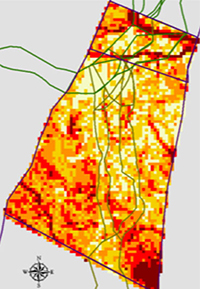A Regional Ecological Assessment Protocol for the South Central United States

Integration of
REAP tool into
GISST. (Courtesy of
EPA)
U.S. Environmental Protection Agency, Region 6
Project Goals
The U.S. Environmental Protection Agency (EPA) Region 6 developed a Regional Ecological Assessment Protocol (REAP) that uses a GIS analysis to classify land on the basis of its ecological significance. This project expands on the Texas Ecological Assessment Protocol, which collected and analyzed data for the State of Texas. The REAP now includes all five States in Region 6 (Arkansas, Louisiana, New Mexico, Oklahoma, and Texas) and portrays significant ecological relationships across State boundaries.
Project Activities and Accomplishments
EPA Region 6 staff collected data by ecoregion, which is an area of land and water defined by climate, geology, and species, rather than political boundaries. EPA Region 6 staff used subsets of national datasets in the REAP and worked with State wildlife agencies to acquire coarse rare species data to aggregate in the REAP model. Datasets included in the REAP are available on an environmental data gateway that expands access to any users with GIS capabilities. In 2012, EPA Region 6 staff integrated the REAP into NEPAssist, an online tool that consolidates information for the National Environmental Policy Act (NEPA) review process. Staff also brought REAP data into the GIS Service Tool (GISST), a screening tool that assesses environmental vulnerabilities by evaluating characteristics captured in REAP along with factors such as habitats and toxicity. Integration of REAP data with these tools makes the information accessible for practitioners, including those without access to or technical expertise in GIS.
EPA staff has conducted training with Departments of Transportation (DOTs) Texas, Arkansas, and New Mexico. All metropolitan planning organizations (MPOs) in those States have access to the REAP, and EPA staff reports that planners use the REAP to identify potential impacts of and mitigation for transportation projects in early planning. The North Central Texas Council of Governments (see page 39) applied the REAP data to develop their Regional Ecosystem Framework, which they used to develop a new chapter devoted to environmental considerations in their Metropolitan Transportation Plan.
Future Steps
EPA would like to expand the REAP data to cover a national scale. As the REAP is already integrated into NEPAssist, which is used across all EPA regions, expanding the data to cover the other regions would make the tool accessible to NEPA practitioners nationwide. Other near-term goals include acquiring and incorporating accurate data on Tribal lands, creating tablet computer applications for NEPAssist, and adapting the REAP for automated updates. EPA staff plans to continue promoting the REAP and other GIS tools among MPOs and State regulatory agencies for application to transportation projects. However, EPA Region 6 has limited staff time to devote to integrating data into transportation due to staff turnover.
Insights on Eco-Logical
EPA Region 6 found that successfully developing a tool like the REAP requires diverse skill in areas such as GIS programming, communications, marketing, graphic design, and crafting interagency agreements. A consistent champion (or champions) is also crucial, although maintaining such a champion in the midst of staff turnover is challenging. Education and outreach are important to help practitioners navigate vast quantities of data and to help them embrace the cultural shift necessary to implement the Eco-Logical approach.
<< Return to Grant Projects

